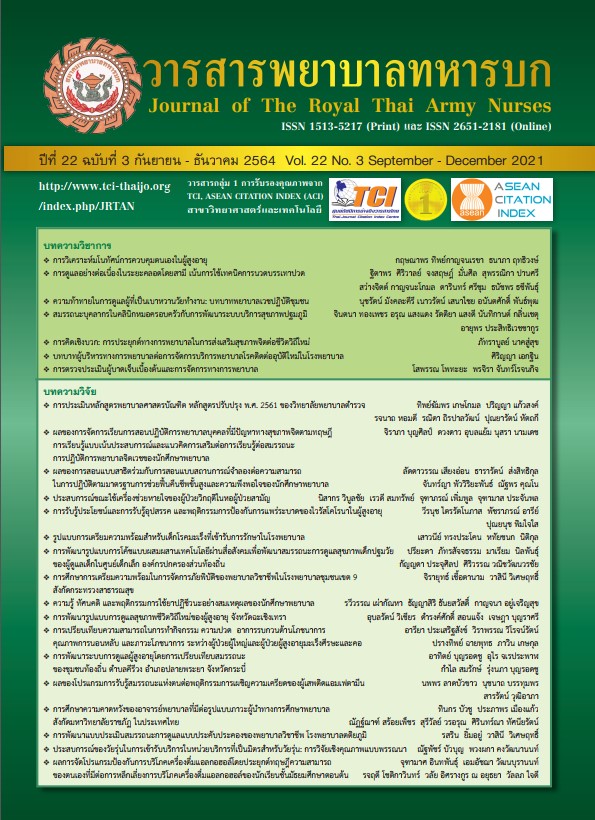The Comparative Study on the Nursing Student’s Perceived Usefulness and Satisfaction on Different Learning Style in Pathophysiology in Nursing Course
Keywords:
blended learning, perceived usefulness, satisfaction, learning styleAbstract
This descriptive research aimed to investigate the learning style and compare the perceived usefulness and satisfaction on blended learning of undergraduate nursing students’ pathophysiology course based on learning style. The participants were 161 second years nursing students. The questionnaires, including personal characteristics, learning style, satisfaction on blended learning, and perceived usefulness were distributed. The instrument reliability was assessed by using Cronbach’s alpha coefficient. The values of the internal consistency reliability were 0.63, 0.91 and 0.83 respectively. The percentage, mean, and standard deviation were used for the initial stage of data analysis and the one-way ANOVA was used to compare the means between two groups. Results showed that most of the participants engaged in one type of learning style (89.4 percent), and dependent learning styles (24.2 percent). The participants who engaged in more than one type of learning style (10.6 percent) had the styles of avoidance combined with competitive learning styles (35.3 percent). In the comparison between the satisfaction and the perceived usefulness of blended learning, the data showed that they had statistically significant differences at p < .05. The study indicated that the learning style of learners was a factor affecting the blended learning method. The instructors should be aware the learners’ learning styles before designing activities. This will enhance their learning skills and will improve their understanding of the lessons.
Downloads
References
Thanormchayathawat B, Vanitsuppavong P, Niemted W, Portjanatani N. 21stcentury skills: a challenge for student development. The Southern College Network Journal of Nursing and Public Health. 2016;3(2):208-22. (in Thai)
Lalima, Dangwal KL. Blended learning: an innovative approach. Universal Journal of Education Research. 2017;5(1):129-36.
Singh H. Building effective blended learning programs. Educatinal Technology archive. 2003;43(6):51-4.
Rueangsawat S, Saetew P, Choome P. The effect of blended learning management on 21st century learning skills for nursing students, boromarajonani college of nursing, suratthani. Journal of The Royal Thai Army Nurses. 2020;21(1):235-44. (in Thai)
Thaewpia S, Potchana R, Intaraphet S. The impact of blended learning on learning achievement satisfaction, and self-directed learning among nursing students. Journal of Nursing Science & Health. 2019;42(4):121-31. (in Thai)
Nantsupawat A, Nantsupawat R. Satisfaction and outcomes of teaching styles with blended learning in a nursing leadership and management course, faculty of nursing, chiang mai university. Nursing Journal 2013; 40:47-60. (in Thai)
Hande S. Strengths weaknesses opportunities and threats of blended learning: students’ perceptions. Annals of Medical and Health Science Research. 2014;4(3):336-9.
Dunn KE, Osborne C, Rakes GC. It’s not my fault; understanding nursing students’ causal attributions in pathophysiology. Nurse Education Today. 2013;33(8):828-33.
Kerzic D, Tomazevic N, Aristovnik A, Umek L. Exploring critical factors of the perceived usefulness of blended learning for higher education students. PLoS One. 2019;14(11): e0223767.
Esia-Donkoh K, Eshun ES, Acquaye VNA. Learning style and factors affecting learning: perception of 2013/2014 final year post-diploma sandwich students of the department of basic education, university of education, winneba (uew), ghana. Advances in Social Science Research. 2015;2(5):34-46.
Grasha AF. Teaching with style: a practical guidline to enhance learning by understanding teaching & learning styles. Pittsburgh: Alliance; 1996.
Ilcin N, Tomruk M, Yesilyaprak SS, Karadibak D, Savci S. The realtionship between learning styles and academic performance in turkish physiotherapy student. BMC Medical Education. 2018;18(291).
Visudtibhan PJ, Disorntatiwat P. Learning style preferences of nursing students at ramathibodi school of nursing, faculty of medicine, ramathibodi hospital, mahidol university. Nursing Journal of Ministry of Public Health. 2015;25(1):70-82. (in Thai)
McVicar A, Andrew S, Kemble R. The bioscience problem’ for nursing students: an integrative review of publish evaluations of year 1 bioscience, and proposed directions for curriculum development. Nurse Education Today. 2015;35:500-9.
Sahoo PK, Chandra SA. A study of the relationship between students’ learning style and instructional inputs in a teacher education programme of ignou. Asian Association of Open Universities Journal. 2014;9(1):17-34.
Yamalee E. Autonomous learning: look in various perspectives for applying. Ratchphruek Journal. 2019;17(3):1-10. (in Thai)
Wang H. Research on multiple intelligences theory and its enlightenment to higher education. Reseach on Modern Higher Education. 2017;3:121-5.
Downloads
Published
How to Cite
Issue
Section
License
บทความหรือข้อคิดเห็นใดใดที่ปรากฏในวารสารพยาบาลทหารบกเป็นวรรณกรรมของผู้เขียน ซึ่งบรรณาธิการหรือสมาคมพยาบาลทหารบก ไม่จำเป็นต้องเห็นด้วย
บทความที่ได้รับการตีพิมพ์เป็นลิขสิทธิ์ของวารสารพยาบาลทหารบก
The ideas and opinions expressed in the Journal of The Royal Thai Army Nurses are those of the authors and not necessarily those
of the editor or Royal Thai Army Nurses Association.






